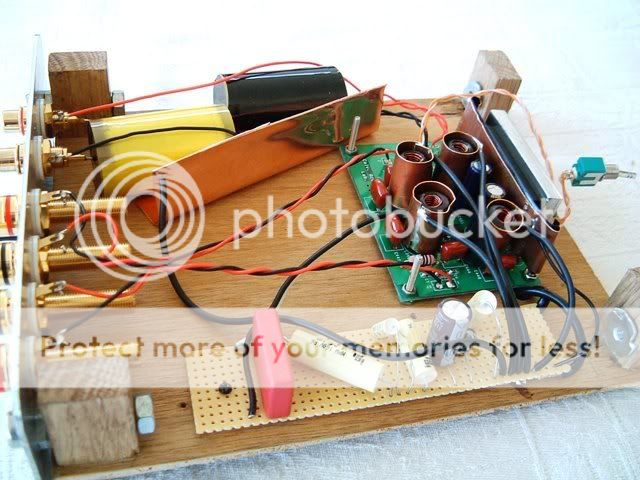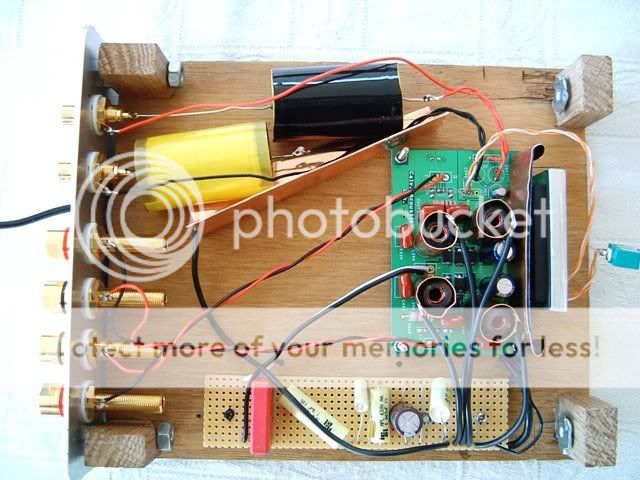Code said:I noticed you have wires attached here:
what are they for? grounding?
It's a powerswitch. If you remove the jumper, the tripath is switched off. Connect a switch and you can choose on or off 🙂
Cheers
Bjorn
Hi Code
According to Infinia: Best place to tie the inductor shields is the reservoir caps near the power switches.
To solder on the copper you need a clean surface and enough heat 🙂
B
According to Infinia: Best place to tie the inductor shields is the reservoir caps near the power switches.
To solder on the copper you need a clean surface and enough heat 🙂
B
Have anyone tried ERS-paper inside Charlize?
A while back there was a lot of talk about this material. It is said to shield components without a ground connection. Some reported a loss in dynamic as a possible negative, however.
It's paper, and of course very easy to manipulate.
A while back there was a lot of talk about this material. It is said to shield components without a ground connection. Some reported a loss in dynamic as a possible negative, however.
It's paper, and of course very easy to manipulate.
Trino said:Have anyone tried ERS-paper inside Charlize?
I have not, but several guys I know have used it and liked it in T-Amps. Enough for me to at least try it.
Perhaps it works but absorbing the RF and converting it to heat?
I'm one of those "guys"😉 I covered the inside of the casing with the stuff and under the board. In addition I have the copper shielding Pan. made on my Trends. Overkill? no doubt! No negative affects that I can hear. I have no idea how it works. Does it "re-route", absorb, cancel, turn into tiny jelly beans? Who knows. It seems "real" and there are reviews. It's highly conductive so you got to real carefull how you use it.
Hi Björn,
I made the mod to my Trends TA-10 ver 1.1 as described in the Trends mod thread. My experience is quite the same as yours.
I would say that the 'blackness' of my amp is substantially improved. We don't have to listen to what others may not hear but experience anyway unmodded. 😀
This ERS thing does sound interesting too for CD and DAC.
/Erling
I made the mod to my Trends TA-10 ver 1.1 as described in the Trends mod thread. My experience is quite the same as yours.
I would say that the 'blackness' of my amp is substantially improved. We don't have to listen to what others may not hear but experience anyway unmodded. 😀
This ERS thing does sound interesting too for CD and DAC.
/Erling
OK for you guy's modding the coils and shields.
1) Changing to air coils could suffer from reduced bass from possibly increasing coils Rdc. Not sure if you are keeping inductance equivalent to stock parts or if feedback is taken at output of filter.
2) Shields around coils can increase current draw, i.e. acts as shorted turn in an air coupled transformer.
Could someone measure the current draw at light loads and no load.
2A) With Out shields (4places).
2B) With shields no ground drains.
2C) Withs shields with ground drains connected to large caps common.
1) Changing to air coils could suffer from reduced bass from possibly increasing coils Rdc. Not sure if you are keeping inductance equivalent to stock parts or if feedback is taken at output of filter.
2) Shields around coils can increase current draw, i.e. acts as shorted turn in an air coupled transformer.
Could someone measure the current draw at light loads and no load.
2A) With Out shields (4places).
2B) With shields no ground drains.
2C) Withs shields with ground drains connected to large caps common.
Yes, the air coils have a higher DCR than a good bobbin or toroid. But for many speakers, the extra DCR can result in a slight increase in bass. So there are trade offs.
I'll do a current draw measurement as soon as I can, good idea!
I'll do a current draw measurement as soon as I can, good idea!
All this shielding talk has got me wondering, it that one of the reasons why C37 lacquer might work? Carbon as you know is electronically conductive and does have some EMI/RFI shielding/absorption/reflection properties. Curious.
Has anyone tried painting on some shielding, whether iit be nickel paint (nice and cheap) or silver lacuer/paint?
Has anyone tried painting on some shielding, whether iit be nickel paint (nice and cheap) or silver lacuer/paint?
Have done some changes according to the advices in this thread.
Earthed the shields to the inputcap. New shield to the Tripath and the caps. A little cooling device for the Tripath is also installed. Can't say there is much differnce in sound. Maybe a touch more airy?


Cheers
bj 🙂
Earthed the shields to the inputcap. New shield to the Tripath and the caps. A little cooling device for the Tripath is also installed. Can't say there is much differnce in sound. Maybe a touch more airy?


Cheers
bj 🙂
this is my ghetto attempt..
i have noticed a distinct improvement in treble, the harshness has disappeared entirely! Also the sound stage has increased in width! 🙂
On another note, what do you guys put between your power supply and amp? I've found nothing at all to be better than a crap 35v jamicon 10,000.
An externally hosted image should be here but it was not working when we last tested it.
i have noticed a distinct improvement in treble, the harshness has disappeared entirely! Also the sound stage has increased in width! 🙂
On another note, what do you guys put between your power supply and amp? I've found nothing at all to be better than a crap 35v jamicon 10,000.
Good work!
Icebear, with the spacious layout you have, shielding may not be a big improvement. The Charlize has a nice loose layout and your input caps and wires are far from the coils.
Also, on the Chralize the inductors are not close together as they are on some amps. When they are right next to each other they really send out some RF!
One thing you may want to try is to shield the entire amp. In this case I'm not thinking about the RF coming from the amp and coils, but all the stuff already in the air. I know at my house the amps pick up a lot of hum and buzz if they aren't in a metal box.
Icebear, with the spacious layout you have, shielding may not be a big improvement. The Charlize has a nice loose layout and your input caps and wires are far from the coils.
Also, on the Chralize the inductors are not close together as they are on some amps. When they are right next to each other they really send out some RF!
One thing you may want to try is to shield the entire amp. In this case I'm not thinking about the RF coming from the amp and coils, but all the stuff already in the air. I know at my house the amps pick up a lot of hum and buzz if they aren't in a metal box.
Any data on current draw with/without inductor shields? (see posts #29)
A note about the shield drain connections. The drain connections really want to be tied to the large caps on the D amp PCB. This helps the bad electrons back from where they came from i.e. part of keeping a small loop area. This makes a difference with the RF currents involved here folks.
A note about the shield drain connections. The drain connections really want to be tied to the large caps on the D amp PCB. This helps the bad electrons back from where they came from i.e. part of keeping a small loop area. This makes a difference with the RF currents involved here folks.
Hi Infinia
I was actually going to measure the current drain, but my ampmeter(multimeter) let me down. Have to get hold of a new one first.
Big caps on the PCB? Maybe I'll look into it tonight 🙂
Maybe I'll look into it tonight 🙂
b
I was actually going to measure the current drain, but my ampmeter(multimeter) let me down. Have to get hold of a new one first.
Big caps on the PCB?
 Maybe I'll look into it tonight 🙂
Maybe I'll look into it tonight 🙂b
I tied the sheild drains to the onboard caps.
Pana said he was going to measure the draw so
I left mine all boxed up being the lazy *** that
I am. What are the concern with increased
current draw other than lowered efficiency?
Pana said he was going to measure the draw so
I left mine all boxed up being the lazy *** that
I am. What are the concern with increased
current draw other than lowered efficiency?
Hi folhaseca
Did the wires from the shield connect to the upper or lower side of the print to reach the caps?
What do you think of the sound after the mod?
Cheers
Bj
Did the wires from the shield connect to the upper or lower side of the print to reach the caps?
What do you think of the sound after the mod?
Cheers
Bj
folhaseca said:What are the concern with increased
current draw other than lowered efficiency?
Hi folhaseca
Yes, reduced efficiency is a possible tradeoff to the shielded coils modification. Also reduced inductance is a concern due to this inductor mod from a shorted secondary turn (shield).
Anytime there's a modification, there are tradeoffs and ramifications, and it's wise to know what they are before commiting to them.
Hi folks.
I havn't been around for a while. Saw this one going on!
Good to see that you experience the same results, which I am enjoying since half a year by now. 😀
I have done it with ERS paper. I also covererd the board from underneath. That's what I do with all my boards! (e.g. DDDAC)
BTW. I know many of you folks will shoot me for this one:
I had a Shakti-Online lying around and glued it to the back
of the chip! This was more than worth it. It still sits there catching all the noise around.
Grain in the sound is more or less gone!
Cheers
I havn't been around for a while. Saw this one going on!
Good to see that you experience the same results, which I am enjoying since half a year by now. 😀
I have done it with ERS paper. I also covererd the board from underneath. That's what I do with all my boards! (e.g. DDDAC)
BTW. I know many of you folks will shoot me for this one:
I had a Shakti-Online lying around and glued it to the back
of the chip! This was more than worth it. It still sits there catching all the noise around.
Grain in the sound is more or less gone!
Cheers
- Status
- Not open for further replies.
- Home
- Amplifiers
- Class D
- Shielding the Charlize